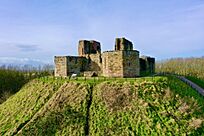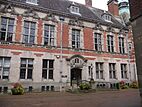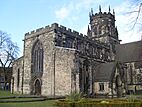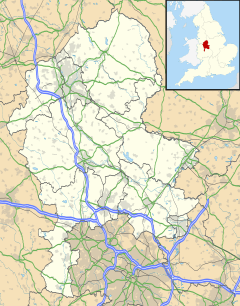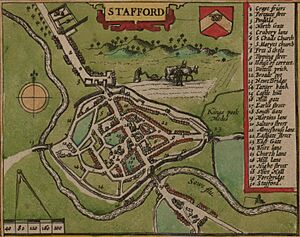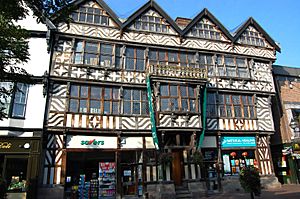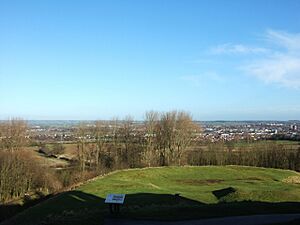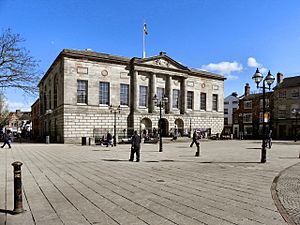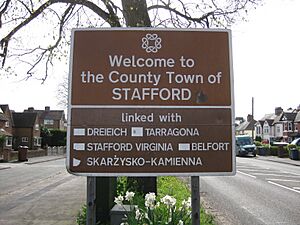Stafford facts for kids
Quick facts for kids Stafford |
|
|---|---|
|
Clockwise from top: Shire Hall, Stafford Castle, St Mary's Church, County Buildings, and Ancient High House |
|
| Population | 71,673 (2021 Census) |
| OS grid reference | SJ922232 |
| District |
|
| Shire county | |
| Region | |
| Country | England |
| Sovereign state | United Kingdom |
| Post town | STAFFORD |
| Postcode district | ST16-ST21 |
| Dialling code | 01785 |
| Police | Staffordshire |
| Fire | Staffordshire |
| Ambulance | West Midlands |
| EU Parliament | West Midlands |
| UK Parliament |
|
Stafford is a lively market town and the main town of Staffordshire, England. It is located about 15 miles (24 km) south of Stoke-on-Trent and 15 miles (24 km) north of Wolverhampton. In 2021, the town had a population of 71,673 people. Stafford is the main part of the larger Borough of Stafford, which had a population of 136,837 in 2021.
Stafford's history goes back to the Anglo-Saxons. It was founded in 913 by Æthelflæd, Lady of Mercia, as a defensive fort. Soon after, it became the county town of Staffordshire. In the Middle Ages, Stafford grew into an important market town. Later, it became a key industrial town, known for making shoes, engineering, and electrical goods.
Contents
- A Look Back in Time: Stafford's History
- Famous Places in Stafford
- Culture and Entertainment
- Media in Stafford
- Stafford's Climate
- Stafford's Economy and Industries
- Stafford's Population and Diversity
- Getting Around Stafford: Transport
- MOD Stafford
- Learning in Stafford: Education
- Sports in Stafford
- The Staffordshire Knot
- Famous People from Stafford
- Nature Reserves in Stafford
- Nearby Places to Visit
- Stafford's Twin Towns
- See also
A Look Back in Time: Stafford's History
Early Settlements
Long ago, before recorded history, people lived in the Stafford area. We know this from ancient finds. About 2.5 miles (4 km) southwest of town, there's an Iron Age hill fort called Berry Ring. There is also proof of Roman activity nearby. It seems the Romans used the marshy land for farming, not for building a town.
Anglo-Saxon Beginnings
The name Stafford means "ford by a landing place." The first settlement was on a small island, surrounded by the River Sow. This river is a branch of the River Trent. A marshy area was to the north. Even with many drains built later, the area can still flood.
Some say Stafford was the island of Bethney, where St Bertelin started a hermitage around AD 700. Later, more people settled here and named it Stafford. In 913, Æthelflæd, Lady of Mercia, built a burh (a fortified town) in Stafford. This was part of her plan to fight the Vikings. A mint was set up by King Æthelstan (924-939). It made coins until the time of Henry II (1154–1189). Stafford also became a place where Roman-style pottery was made and sent to other fortified towns.
Around this time, the county of Staffordshire was formed, with Stafford as its main town.
Norman and Medieval Times
In 1069, a rebellion against the Norman Conquest happened in Stafford. The Anglo-Welsh army was defeated by Norman forces. After this battle, and a period of destruction in the North, Stafford lost many people. By 1086, much of the town was empty.
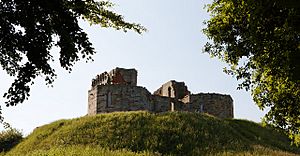
Stafford Castle was first built by the Normans around 1090. It was on a hilltop west of the town. The first castle was made of wood, then rebuilt in stone around 1348. It has been rebuilt again since then. An earlier wooden castle was built closer to the town in 1070, but its exact location is now unknown.
By 1086, Stafford was a walled town. The walls were likely wooden at first, then rebuilt in stone. There were four gates leading into the town. By 1670, the walls were falling apart and were slowly taken down.
Stafford became an important market town during the Middle Ages. It was known for trading cloth and wool. By the 1280s, many trades were active, like tanning (making leather), glove making, and shoe making. Shoemakers even formed their own group in 1476.
Medieval Stafford had two churches: St Chad's, built in the mid-12th century, and St Mary's, built in the early 13th century. In 1399, King Richard II was paraded through the town as a prisoner.
Tudor Period
In 1521, Stafford was called a "proper and fair town." However, it faced a decline during the Tudor period. By 1540, many houses were in disrepair. Queen Elizabeth I visited Stafford in 1575, when the town was still in a state of decay.
The Ancient High House was built in 1595. It is thought to be the largest timber-framed town house in England. It was carefully restored between 1976 and 1986.
17th Century Events
When King James I visited Stafford in 1617, he was very impressed. He called it "Little London" because of its buildings like the Shire Hall.
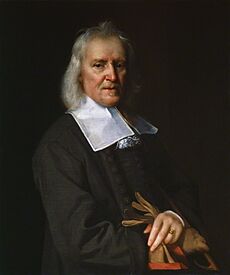
During the English Civil War, Stafford was first held by the Royalists. King Charles I stayed at the Ancient High House in September 1642. The town fought off two attacks by the Parliamentarians in February 1643. But in May 1643, Parliamentarian forces captured the town. Stafford then became a key Parliamentarian center. Stafford Castle was defended by Lady Isabel Stafford, but it was also taken by Parliamentarians in 1643. The castle was later ordered to be torn down. Stafford's famous writer, Izaak Walton, author of The Compleat Angler, was a strong Royalist.
In 1658, Stafford elected John Bradshaw to Parliament. He was the judge at the trial of King Charles I. Later, during the reign of Charles II, William Howard, 1st Viscount Stafford was accused in the Popish Plot. This was a false claim of a plan to kill the king. Lord Stafford was tried and executed in 1680. The charge was later found to be false.
From the 18th Century to Today
From 1780, the playwright Richard Brinsley Sheridan represented Stafford in Parliament. During this time, the town's shoe industry began using machines. William Horton was a well-known factory owner. Shoemaking became Stafford's main trade, with 39 manufacturers in the 1880s. The industry slowly declined, and the last shoe factory closed in 1998.
In 1814, Stafford was connected to the canal system by the River Sow Navigation. This short canal linked Stafford to the Staffordshire and Worcestershire Canal. It stopped being used in the 1930s.
The first railways arrived in Stafford in 1837. The Grand Junction Railway connected Stafford to Birmingham and then to London. The Trent Valley Railway opened in 1847, offering a direct route to London. Stafford became a major railway hub, which attracted new industries.
In the late 1800s, Stafford's economy grew into engineering. W. G. Bagnall opened a large factory in 1875, making locomotives. In the early 1900s, electrical engineering became important when Siemens Brothers opened a factory. They made electrical motors, generators, and transformers. This electrical industry has been owned by several companies over the years, including English Electric and GEC.
The Friars' Walk drill hall was finished in 1913, just before the First World War. The M6 motorway opened west of Stafford in 1962. In 2013, Stafford celebrated its 1,100th birthday with history exhibitions.
Stafford's Borough History
Stafford was an old town with its own local government by 1086. Its status as a borough was confirmed in 1206 by King John. Stafford became a municipal borough again in 1835. The town's boundaries grew in 1876, 1917, and 1934.
The modern Borough of Stafford is much larger than the town itself. It was created in 1974. This happened when the old borough of Stafford joined with other local districts.
How Stafford's Population Grew
The table below shows how Stafford's population has changed over time.
| Year | 1622 | 1801 | 1831 | 1861 | 1881 | 1911 | 1951 | 1971 | 2001 | 2021 |
|---|---|---|---|---|---|---|---|---|---|---|
| Population* |
1,550 | 3,898 | 6,956 | 12,532 | 19,977 | 23,383 | 40,263 | 55,001 | 62,789 | 71,673 |
Famous Places in Stafford
The Elizabethan Ancient High House is in the town centre. It is the largest timber-framed town house in England. Today, it is a museum with changing exhibitions.
Stafford Castle was built by the Normans on a nearby hilltop around 1090. It replaced an earlier fort in the town. The first castle was made of wood, then rebuilt in stone. It has been rebuilt twice since. The ruins of the 19th-century Gothic castle still stand on the old earthworks. The castle has a visitor centre with videos and hands-on items. There is also a recreated medieval herb garden. Shakespeare plays are performed in the castle grounds every summer. The castle is easy to spot from the M6 motorway.
The oldest building in Stafford is St Chad's Church. It dates back to the 12th century. The main part of the church is beautifully decorated. Carvings on its arches and pillars might have been made by stonemasons from the Middle East. They came to England during the Crusades. Much of the stonework was covered up later. In the 19th century, during a restoration, the Norman decorations were found again. The church also has "Timewalk," a computer display about its history.
St Mary's, the collegiate church was rebuilt in the early 13th century. It has an impressive octagonal tower. The church was like two churches in one, separated by a screen. The local people used the nave, and the church officials used the chancel. St Mary's was restored in 1842.
The Shire Hall was built in 1798. It was used as a court house and offices for the Mayor. The Shire Hall is a Grade II listed building. Recently, it was an art gallery and library. The Market Square was redeveloped in 2023.
Green Hall on Lichfield Road is a Grade II listed manor house. It was built around 1810. It has been a girls' school and council offices. Now it is apartments.
The Shugborough Hall country estate is 4 miles (6.4 km) outside of town. It used to belong to the Earls of Lichfield. Now, the National Trust owns it. The 19th-century Sandon Hall is 5 miles (8 km) northeast of Stafford. It is set in 400 acres (1.6 km2) of parkland. Weston Hall is 5 miles (8 km) east of Stafford, in the Trent valley. It has a large park and was once part of the Chartley estate.
Culture and Entertainment
Stafford Gatehouse Theatre is the town's main place for shows and culture. Its Met Studio hosts stand-up comedy and live music. There is an art gallery in the Shire Hall. Staffordshire County Showground, just outside town, holds many events. The yearly Shakespeare Festival at Stafford Castle has attracted famous people.
Victoria Park opened in 1908. It is a 13-acre (5.3 ha) Edwardian park by the river. It has a play park, bowling green, and areas for birds and plants. There is a children's play area, a water jet area, and a bmx/skateboard area. Stafford also has a 9-hole golf course near the town centre.
New buildings by the Riverside have expanded the town. This includes a new Odeon cinema. Stafford Film Theatre shows independent films at the Gatehouse Theatre. There is a tenpin bowling alley at Greyfriars Place. The new Stafford Leisure Centre opened in 2008.
Stafford has many bars and clubs for nightlife. These include Casa, the Grapes, and the Picture House. There are also rock gigs at Redrum. Many students from nearby towns visit these places. A new shopping centre opened in 2017 with major stores and restaurants. The Guildhall shopping centre is now closed.
Media in Stafford
Newspapers
Stafford is covered by the Express and Star and Staffordshire Newsletter. Neither newspaper has offices in the town.
Television
Stafford receives TV from BBC West Midlands and ITV Central. Both broadcast from Birmingham to the wider West Midlands region. Most residents get their signal from the Sutton Coldfield transmitting station. Some get a better picture from The Wrekin transmitting station.
Radio
For local BBC radio, Stafford is covered by BBC Radio Stoke. For commercial radio, Greatest Hits Radio broadcasts on 96.9 FM. Stafford can also receive other West Midlands stations like Heart West Midlands. BFBS Gurkha Radio broadcasts locally on 1278 kHz. Stafford's own community radio station, Stafford FM, launched in 2015. It rebranded to Vibe 1 in April 2024. It is the only commercial radio station broadcasting from Stafford.
Stafford's Climate
Like most of the British Isles, Stafford has a maritime climate. This means it has cool summers and mild winters. The nearest official weather station is at Penkridge, about 5 miles (8 km) south.
| Climate data for Stafford 101 m asl, 1991–2020 | |||||||||||||
|---|---|---|---|---|---|---|---|---|---|---|---|---|---|
| Month | Jan | Feb | Mar | Apr | May | Jun | Jul | Aug | Sep | Oct | Nov | Dec | Year |
| Mean daily maximum °C (°F) | 7.29 (45.12) |
8.06 (46.51) |
10.51 (50.92) |
13.53 (56.35) |
16.60 (61.88) |
19.45 (67.01) |
21.77 (71.19) |
21.27 (70.29) |
18.57 (65.43) |
14.45 (58.01) |
10.44 (50.79) |
7.66 (45.79) |
14.16 (57.49) |
| Mean daily minimum °C (°F) | 1.83 (35.29) |
1.83 (35.29) |
3.10 (37.58) |
4.56 (40.21) |
7.20 (44.96) |
9.98 (49.96) |
11.97 (53.55) |
11.79 (53.22) |
9.87 (49.77) |
7.28 (45.10) |
4.32 (39.78) |
2.01 (35.62) |
6.34 (43.41) |
| Average precipitation mm (inches) | 56.69 (2.23) |
43.05 (1.69) |
42.50 (1.67) |
48.78 (1.92) |
55.47 (2.18) |
61.43 (2.42) |
61.01 (2.40) |
60.12 (2.37) |
61.53 (2.42) |
67.48 (2.66) |
67.43 (2.65) |
66.37 (2.61) |
691.86 (27.24) |
| Mean monthly sunshine hours | 46.04 | 66.35 | 105.78 | 148.68 | 185.47 | 166.10 | 182.71 | 161.23 | 127.60 | 95.72 | 57.96 | 42.52 | 1,386.16 |
| Source: The Met Office | |||||||||||||
Stafford's Economy and Industries
Shoemaking History
Stafford has a long history of making shoes, going back to 1476. It started as a small home industry. But in the 1700s, factories began making shoes. William Horton started a business in 1767 that became the biggest shoe company in Stafford. It sold shoes all over the world. The shoe industry slowly ended in the late 20th century. Lotus Shoes was the last company. Its factory was torn down in 2001 and houses were built there.
Engineering and Manufacturing
In 1875, a company called WG Bagnall started making locomotives (train engines). They built 1,869 locomotives until 1962. Since 1901, a major industry has been heavy electrical engineering. This includes making large power station transformers. These works have been owned by companies like Siemens Brothers and GEC. Today, General Electric owns the works. Stafford is a centre for making HVDC and AC substations. Each transformer can weigh hundreds of tons.
British Reinforced Concrete Engineering (BRC) opened a large factory in Stafford in 1926. In the late 1970s, BRC employed about 750 people. However, the business declined, and the factory closed in 1990. Perkins Engines has a factory in Littleworth that makes diesel engines. Many people who live in Stafford also travel to work in Stoke-on-Trent and Birmingham.
Universal Grinding Wheel Ltd started in Stafford in 1913. Its factory grew to cover 44 acres (18 ha). By the 1970s, it was Europe’s largest maker of grinding wheels. The company was bought by others and became part of Saint-Gobain. The business moved to a new industrial park, and the old factory was demolished in 2019.
Another company, Bostik, which makes adhesives, has a factory on Common Road.
Public Services and Education
Many people in Stafford work for public services. These include Staffordshire County Council, Stafford Borough Council, and Staffordshire Police. Stafford Prison, County Hospital, and Beacon Barracks also provide many jobs.
Staffordshire University used to have a large campus in Stafford for computer science and IT. Most of these courses have moved to Stoke-on-Trent. The only part of the university left in Stafford is the School of Health. It teaches medical nursing.
The Guildhall Shopping Centre in the town centre used to have over 40 shops, but it has since closed. The town also has several large supermarkets. The Stafford Railway Building Society was founded in 1877. It changed its name to the Stafford Building Society in 2024.
Stafford's Population and Diversity
In 2021, Stafford had 70,145 residents. This was an increase from 68,472 in 2011.
In terms of different backgrounds in 2021:
- 90.6% of Stafford residents were White.
- 4.5% were Asian.
- 1.6% were Black.
- 2.3% were Mixed.
- 0.7% were from another ethnic group.
Regarding religion, 51.8% of Stafford residents said they were Christian. 42.9% said they had no religion. Other religions included Muslim (1.7%), Hindu (1.5%), Sikh (0.8%), and Buddhist (0.6%).
Getting Around Stafford: Transport
Train Travel
Stafford railway station was once a very busy train hub. However, some train lines were closed in the past. Today, trains operated by Arriva CrossCountry stop at Stafford often. These trains go between Manchester Piccadilly and Birmingham New Street. They then continue to Bristol Temple Meads or Bournemouth.
Avanti West Coast trains go to London Euston and Liverpool Lime Street every hour. West Midlands Trains also runs services between Crewe and London Euston. They also have a service between Birmingham New Street and Liverpool Lime Street.
Roads and Motorways
Stafford is easy to reach from the M6 motorway at Junctions 13 and 14. This means Birmingham and Manchester are simple to get to. The A34 runs through the town centre. It connects Stafford to Stone and Stoke-on-Trent in the north. It also links to the West Midlands cities like Birmingham and Wolverhampton in the south. The A518 road connects Stafford to Telford and Uttoxeter. The A449 goes south from the town centre to Penkridge and Wolverhampton. The A513 goes east from Stafford to Rugeley and Lichfield.
Bus Services
Local bus services in Stafford are run by D&G Bus. They operate services to Lichfield, Cannock, Uttoxeter, and Rugeley. Select Bus Services run local routes to the town's suburbs. Arriva Midlands has a service to Telford. Services to Stone and Stoke-on-Trent are handled by First Potteries. Stafford also has several taxi companies.
Canal Connections
The Staffordshire and Worcestershire Canal runs near the Baswich and Wildwood areas. It used to be connected to the River Sow by the River Sow Navigation.
MOD Stafford
MOD Stafford is a military base located on Beaconside. It used to be an RAF station but was renamed MOD Stafford in 2006. The base employs both civilians and military staff. It now houses two Royal Signals units and an RAF Regiment group.
Learning in Stafford: Education
Primary Schools
- Anson CE (A) Primary School
- Barnfields Primary School
- Berkswich CE Primary School
- Blessed Mother Teresa RC Primary School
- Brooklands Preparatory School (Independent)
- Burton Manor Primary School
- Castlechurch Primary School
- Cooper Perry Primary School
- Flash Ley Community Primary School
- John Wheeldon Primary School
- Leasowes Primary School
- Oakridge Primary School
- Parkside Primary School
- Rowley Park Primary Academy
- Silkmore Primary School
- Stafford Preparatory School
- St Anne's RC Primary School
- St Austin's RC Primary School
- St Bede's Preparatory School (Independent)
- St John's CE Primary School
- St Leonard's Primary School
- St Patrick's Catholic Primary School
- St Paul's Primary School
- Doxey Primary School
- Tillington Manor Primary School
Secondary Schools
- Blessed William Howard Catholic School
- King Edward VI High School
- Stafford Grammar School. This is a private school.
- Stafford Manor High School
- Sir Graham Balfour School
- Walton High School
- Weston Road Academy
Colleges and Universities
Stafford College is a large college for further education. It also offers some university-level courses through Staffordshire University. These courses focus on computing and engineering.
South Staffordshire College has a campus near Stafford in the village of Rodbaston. It is mainly an agricultural college.
Staffordshire University used to have a big campus in Stafford. It focused on computing, engineering, and media. This part of the campus closed in 2016. Most facilities moved to Stoke-on-Trent. The university still has a presence at its Blackheath Lane campus for health courses, like nursing.
Sports in Stafford
Stafford has three association football (soccer) clubs: Stafford Rangers F.C., Brocton F.C., and Stafford Town F.C.. None of them play at a fully professional level.
The town has two rugby union clubs. There is also a local hockey club with eight adult teams. Stafford Post Office Rifle and Pistol Club was founded in 1956. It has an indoor range and uses outdoor ranges for larger guns.
Stafford Cricket and Hockey Club was founded in 1864. It is likely the town's oldest sports club. The club moved to Riverway in 1984. It now owns 11 acres (4.5 ha) and hosts many sports. These include two cricket pitches in summer and football, mini-football, rugby, and hockey in winter. In 1999, the club received a grant for a new building. The cricket section welcomes players of all skill levels.
In 2018, a parkrun (a free weekly 5k run/walk) started in Stafford. It takes place on Saturday mornings on the Isabel Trail. This path follows part of the old Stafford–Uttoxeter railway line.
The Staffordshire Knot
The Stafford knot is a special three-looped design. It is a traditional symbol of the county and the town. You can see it on buildings, logos, and coats of arms. It is also the name of a pub.
Famous People from Stafford
Many notable people have connections to Stafford. These include:
- Izaak Walton (17th century), author of The Compleat Angler. His cottage nearby is now a museum.
- Richard Brinsley Sheridan (18th century), a playwright and former local Member of Parliament.
- Thomas Sidney (1853), a Lord Mayor of London, was born here.
- J. R. R. Tolkien, author of The Lord of the Rings, lived near Stafford in 1916. The local areas are said to have inspired his early writings.
- Carol Ann Duffy, a Scottish poet and playwright, grew up in Stafford. She was the Poet laureate from 2009 to 2019.
- Ralph de Stafford (1301–1372), a famous soldier in the Hundred Years' War.
- Henry Stafford, 1st Baron Stafford (1501–1563), who supported Catholic missions in the town.
- Richard Barnfield (1574–1620), a poet with a connection to William Shakespeare.
- Thomas Maxfield (c. 1590–1616), a Roman Catholic priest and martyr, born in Stafford gaol.
- Sir Robert Pigot, 2nd Baronet (1720–1796), a British Army officer during the American Revolutionary War.
- Lieutenant General Sir William Congreve, 1st Baronet (1742–1814), who improved artillery.
- James Oatley, Sr. (c. 1769–1839), an Australian watchmaker and former convict.
- James Trubshaw (1777–1853), an English builder and engineer.
- John Prescott Knight (1803–1881), an English portrait painter.
- George Smith (1805–1874), known as Throttler Smith, a hangman at Stafford gaol.
- William Palmer (1824–1856), a doctor found guilty of murder and executed in Stafford Prison.
- Benjamin Broomhall (1829–1911), an author and supporter of foreign missions.
- Francis Webb (1836–1906), a British engineer who designed locomotives.
- Edward Ilsley (1838–1926), a Catholic Archbishop of Birmingham.
- William Gordon Bagnall (1852–1907), who founded the locomotive company W.G. Bagnall.
- Alice Hawkins (1863–1946), a leading English suffragette.
- Rodney Milnes (1936–2015), a music critic and translator.
- Dave Follows (1941–2003), a British cartoonist.
- Patrick Fyffe (1942–2002), creator of Dame Hilda Bracket.
- Pete Haycock (1951–2013), musician and founding member of the Climax Blues Band.
- Storm Constantine (1956–2021), a science fiction and fantasy author.
- Mark Curry (born 1961), actor and TV presenter.
- Neil Morrissey (born 1962), actor, known for Men Behaving Badly.
- Climax Blues Band, a popular blues band formed in Stafford in 1968.
- Dominic Mafham (born 1968), actor.
- Dave Gorman (born 1971), comedian and author.
- Fran Healy (born 1973), singer for Travis.
- Kieron Gillen (born 1975), computer games journalist and comic book author.
- Tom Vaughan (born 1985), television actor.
- Bizarre Inc, a rave music act formed in 1989.
- Altern-8, a rave music act formed in Stafford in 1990.
- Anna Chell (born 1994), English actress.
- Charles Baker (1867–1924), footballer for Stoke F.C.
- Joe Hulme (1904–1991), English footballer for Arsenal F.C. and cricketer.
- Brian Little (born 1953), former Aston Villa player and manager.
- Nigel Callaghan (born 1962), professional footballer.
- Chris Birchall (born 1984), footballer.
- Joe Leach (born 1990), cricketer for Worcestershire.
- Nick Yelloly (born 1990), auto racing driver.
- Morgan Gibbs-White (born 2000), English footballer for Nottingham Forest F.C..
Nature Reserves in Stafford
These nature reserves are located in Stafford:
- Astonfields Balancing Lakes are two lakes built for flood protection. They are a mile north of the town centre.
- Doxey Marshes is a wet grassland area managed by the Staffordshire Wildlife Trust. It is two miles northwest of the town centre.
- Kingsmead Marsh is a small area of marshland near the town centre.
- Radford Meadows is a floodplain managed by the Staffordshire Wildlife Trust. It is two miles south of the town centre.
Nearby Places to Visit
- Brewood
- Cannock
- Cannock Chase
- Creswell
- Eccleshall
- Great Haywood
- Heath Hayes and Wimblebury
- Hednesford
- Hixon
- Lichfield
- Little Haywood
- Newport, Shropshire
- Penkridge
- Rugeley
- Shugborough Hall
- Stoke-on-Trent
- Stone
- Trentham Gardens
- Uttoxeter
- Wolverhampton
Stafford's Twin Towns
Stafford is twinned with these towns:
- Belfort, France
- Dreieich, Germany
- Skarżysko-Kamienna, Poland
- Stafford, Virginia, United States
- Tarragona, Spain
See also
 In Spanish: Stafford para niños
In Spanish: Stafford para niños




